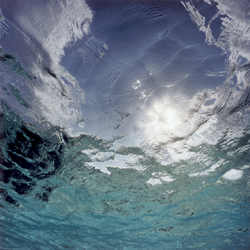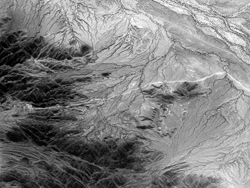September 8 - October 13, 2012
Reception: September 8, 2012 4-6PM
James Fee once described his life and art-making as an act of “staying afloat.” This was not a simple reference to keeping his head above water financially, but a more philosophical reflection upon the balancing of ideals versus harsh realities. He likened the maintenance of one’s ethics, as well as the unifying principles of community and country, to the soundness of a boat. Bodies of water, on the other hand, could float a ship as well as become a cemetery for its rust and decay. The exhibition, Buoyancy, opening at Craig Krull Gallery on July 21st, will explore James Fee’s life-long identification of boats, water, islands and bridges as visual metaphors. Fee often photographed sinking ships as symbols of societal malaise, but his photographic practice was really a personal catharsis and self-revelation. Ultimately, bodies of water became the healing and calm that delivered his re-birth.
This exhibition will include James Fee’s photographs of the legendary ocean-liner, the SS United States as it sat waiting to be dismantled. The artist himself had already begun to feel alienated from his native America, and his images of the once glorious ship embodied obsolescence of a physical as well as a spiritual nature. Later, in his Four Days in New York series, Fee photographed an extraordinary “graveyard” of tugboats and ferries at Staten Island, and made an haunting negative of the Brooklyn Bridge which he ripped in half, entitling the resulting print, Broken Span. For him, bridges could be symbolic of community work ethic and pride, as well a connection between people, or a life passage. Fee’s inner conflict with the state of American civilization was rooted in his relationship with his father. A WWII veteran of the horrific battle of Peleliu, Russell Fee suffered war trauma for the rest of his life. James’s decision not to enlist for the Vietnam War caused a great rift between the two and Russell eventually committed suicide. James Fee used his photography to come to terms with this defining issue of his family, making photographs of submerged planes and other remnants of war on the island of Peleliu. Several images were made underwater, looking up into the light. Like other literary figures and image-makers throughout the ages, Fee regarded light as a symbol of hope, understanding and re-birth.
Concurrently, the gallery will present an exhibition of Rose-Lynn Fisher’s recent aerial photographs entitled, Yonder. In her previous exhibition at Craig Krull Gallery, Fisher showed microscopic images of bees that, as she states, “altered my perception of scale and distance, and gave me a hint of the worlds within worlds that comprise our universe.” Her new aerial photos, made at 37,000 feet demonstrate how “a winding river with tributaries could just as well be a microscopic view of veins and capillaries.” The images are made in a very intimate scale of 4 x 6” on delicate, sheer Japanese Asuka paper.

